As a new input device, the touch screen is currently the simplest, most convenient and natural way of human-computer interaction.
The touch screen, also known as "touch screen" or "touch panel", is an inductive liquid crystal display device that can receive input signals such as contacts; when the graphic buttons on the screen are touched, the tactile feedback system on the screen can Various connecting devices are driven according to pre-programmed programs, which can be used to replace mechanical button panels and create vivid audio and video effects through LCD screens. The main application areas of Ruixiang's touch screens are medical equipment, industrial fields, handheld devices, Smart home, human-computer interaction, etc.
Common touch screen classifications
There are several main types of touch screens on the market today: resistive touch screens, surface capacitive touch screens and inductive capacitive touch screens, surface acoustic wave, infrared, and bending wave, active digitizer and optical imaging touch screens. There can be two types of them, one type requires ITO, such as the first three types of touch screens, and the other type does not require ITO in the structure, such as the latter types of screens. Currently on the market, resistive touch screens and capacitive touch screens using ITO materials are the most widely used. The following introduces knowledge related to touch screens, focusing on resistive and capacitive screens.
Touch screen structure
A typical touch screen structure generally consists of three parts: two transparent resistive conductor layers, an isolation layer between the two conductors, and electrodes.
Resistive conductor layer: The upper substrate is made of plastic, the lower substrate is made of glass, and conductive indium tin oxide (ITO) is coated on the substrate. This creates two layers of ITO, separated by some isolating pivots about a thousandth of an inch thick.
Electrode: It is made of materials with excellent conductivity (such as silver ink), and its conductivity is about 1000 times that of ITO. (Capacitive touch panel)
Isolation layer: It uses a very thin elastic polyester film PET. When the surface is touched, it will bend downward and allow the two layers of ITO coating below to contact each other to connect the circuit. This is why the touch screen can achieve touch The key. surface capacitive touch screen.

Resistive touch screen
Simply put, a resistive touch screen is a sensor that uses the principle of pressure sensing to achieve touch. resistive screen
Resistive touch screen principle:
When a person's finger presses the surface of the resistive screen, the elastic PET film will bend downward, allowing the upper and lower ITO coatings to contact each other to form a touch point. An ADC is used to detect the voltage of the point to calculate the X and Y axis coordinate values. resistive touchscreen
Resistive touch screens usually use four, five, seven or eight wires to generate screen bias voltage and read back the reporting point. Here we mainly take four lines as an example. The principle is as follows:
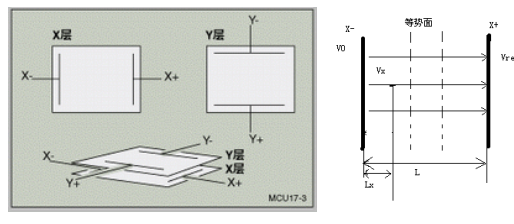
1. Add a constant voltage Vref to the X+ and X- electrodes, and connect Y+ to a high-impedance ADC.
2. The electric field between the two electrodes is uniformly distributed in the direction from X+ to X-.
3. When the hand touches, the two conductive layers come into contact at the touch point, and the potential of the X layer at the touch point is directed to the ADC connected to the Y layer to obtain the voltage Vx. resistive screen
4. Through Lx/L=Vx/Vref, the coordinates of the x point can be obtained.
5. In the same way, connect Y+ and Y- to the voltage Vref, the coordinates of the Y-axis can be obtained, and then connect the X+ electrode to the high-impedance ADC to obtain. At the same time, the four-wire resistive touch screen can not only obtain the X/Y coordinates of the contact, but also measure the pressure of the contact.
This is because the greater the pressure, the fuller the contact, and the smaller the resistance. By measuring the resistance, the pressure can be quantified. The voltage value is proportional to the coordinate value, so it needs to be calibrated by calculating whether there is a deviation in the voltage value of the (0, 0) coordinate point. resistive screen
Resistive touch screen advantages and disadvantages:
1. The resistive touch screen can only judge one touch point each time it works. If there are more than two touch points, it cannot be judged correctly.
2. Resistive screens require protective films and relatively more frequent calibrations, but resistive touch screens are not affected by dust, water, and dirt. resistive touch screen panel
3. The ITO coating of the resistive touch screen is relatively thin and easy to break. If it is too thick, it will reduce the light transmission and cause internal reflection to reduce the clarity. Although a thin plastic protective layer is added to the ITO, it is still easy to be sharpened. It is damaged by objects; and because it is often touched, small cracks or even deformation will appear on the surface ITO after a certain period of use. If one of the outer ITO layers is damaged and breaks, it will lose its role as a conductor and the life of the touch screen will not be long. . resistive touch screen panel
capacitive touch screens, capacitive touch screens
Unlike resistive touch screens, capacitive touch does not rely on finger pressure to create and change voltage values to detect coordinates. It mainly uses the human body's current induction to work. capacitive touch screens
Capacitive touch screen principle:
Capacitive screens work through any object that holds an electric charge, including human skin. (The charge carried by the human body) Capacitive touch screens are made of materials such as alloys or indium tin oxide (ITO), and charges are stored in micro-electrostatic networks that are thinner than hair. When a finger clicks on the screen, a small amount of current will be absorbed from the contact point, causing a voltage drop in the corner electrode, and the purpose of touch control is achieved by sensing the weak current of the human body. This is why the touch screen fails to respond when we put on gloves and touch it. projected capacitive touch screen
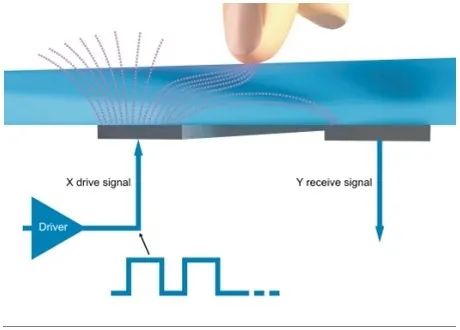
Capacitive screen sensing type classification
According to the induction type, it can be divided into surface capacitance and projected capacitance. Projected capacitive screens can be divided into two types: self-capacitive screens and mutual capacitive screens. The more common mutual capacitive screen is an example, which is composed of driving electrodes and receiving electrodes. surface capacitive touch screen
Surface capacitive touch screen:
Surface capacitive has a common ITO layer and a metal frame, utilizing sensors located at the four corners and a thin film evenly distributed across the surface. When a finger clicks on the screen, the human finger and the touch screen act as two charged conductors, approaching each other to form a coupling capacitor. For high-frequency current, the capacitor is a direct conductor, so the finger draws a very small current from the contact point. The current flows out from the electrodes at the four corners of the touch screen. The intensity of the current is proportional to the distance from the finger to the electrode. The touch controller calculates the position of the touch point. projected capacitive touch screen

Projected capacitive touch screen:
One or more carefully designed etched ITO are used. These ITO layers are etched to form multiple horizontal and vertical electrodes, and independent chips with sensing functions are staggered in rows/columns to form an axis-coordinate sensing unit matrix of projected capacitance. : The X and Y axes are used as separate rows and columns of coordinate sensing units to detect the capacitance of each grid sensing unit. surface capacitive touch screen
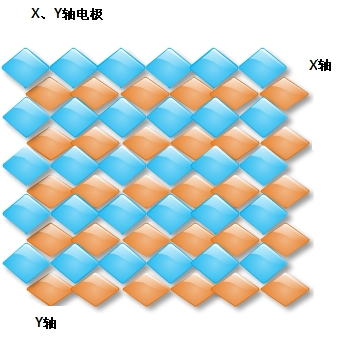
Basic parameters of capacitive screen
Number of channels: The number of channel lines connected from the chip to the touch screen. The more channels there are, the higher the cost and the more complex the wiring. Traditional self-capacity: M+N (or M*2, N*2); mutual capacity: M+N; incell mutual capacity: M*N. capacitive touch screens
Number of nodes: The number of valid data that can be obtained by sampling. The more nodes there are, the more data can be obtained, the coordinates calculated are more precise, and the contact area that can be supported is smaller. Self-capacity: the same as the number of channels, mutual capacity: M*N.
Channel spacing: distance between adjacent channel centers. The more nodes there are, the smaller the corresponding pitch will be.
Code length: only mutual tolerance needs to increase the sampling signal in order to save sampling time. The mutual capacitance scheme may have signals on multiple drive lines at the same time. How many channels have signals depends on the code length (usually 4 codes are the majority). Because decoding is required, when the code length is too large, it will have a certain impact on fast sliding. capacitive touch screens
Projected capacitive screen principle capacitive touch screens
(1) Capacitive touch screen: Both horizontal and vertical electrodes are driven by a single-ended sensing method.
The glass surface of the self-generated capacitive touch screen uses ITO to form horizontal and vertical electrode arrays. These horizontal and vertical electrodes form capacitors with the ground respectively. This capacitance is commonly referred to as self-capacitance. When a finger touches the capacitive screen, the capacitance of the finger will be superimposed on the capacitance of the screen. At this time, the self-capacitive screen detects the horizontal and vertical electrode arrays and determines the horizontal and vertical coordinates respectively based on the changes in capacitance before and after the touch, and then Touch coordinates combined into a plane.
The parasitic capacitance increases when the finger touches: Cp'=Cp + Cfinger, where Cp- is the parasitic capacitance.
By detecting the change in parasitic capacitance, the location touched by the finger is determined. capacitive touch screens
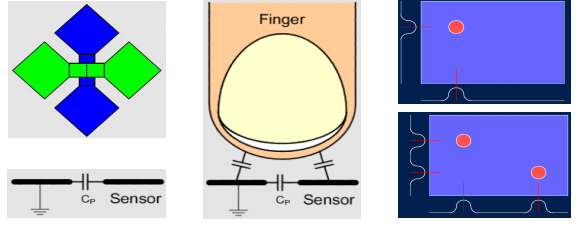
Take the double-layer self-capacitance structure as an example: two layers of ITO, horizontal and vertical electrodes are grounded respectively to form self-capacitance, and M+N control channels. ips lcd capacitive touch screen
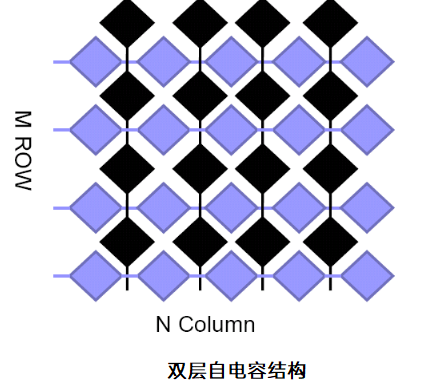
For self-capacitive screens, if it is a single touch, the projection in the X-axis and Y-axis directions is unique, and the combined coordinates are also unique. If two points are touched on the touch screen and the two points are in different XY axis directions, 4 coordinates will appear. But obviously, only two coordinates are real, and the other two are commonly known as "ghost points". ips lcd capacitive touch screen
Therefore, the principle characteristics of the self-capacitive screen determine that it can only be touched by a single point and cannot achieve true multi-touch. ips lcd capacitive touch screen
Mutual capacitive touch screen: The sending end and receiving end are different and cross vertically. capacitive multi touch
Use ITO to make transverse electrodes and longitudinal electrodes. The difference from self-capacitance is that a capacitance will be formed where the two sets of electrodes intersect, that is, the two sets of electrodes respectively form the two poles of the capacitance. When a finger touches the capacitive screen, it affects the coupling between the two electrodes attached to the touch point, thereby changing the capacitance between the two electrodes. capacitive multi touch
When detecting mutual capacitance, the horizontal electrodes send out excitation signals in sequence, and all the vertical electrodes receive signals at the same time. In this way, the capacitance values at the intersection points of all horizontal and vertical electrodes can be obtained, that is, the capacitance size of the entire two-dimensional plane of the touch screen, so that it can be realized. multi touch.
The coupling capacitance decreases when a finger touches it.
By detecting the change in coupling capacitance, the position touched by the finger is determined. CM - coupling capacitor. capacitive multi touch
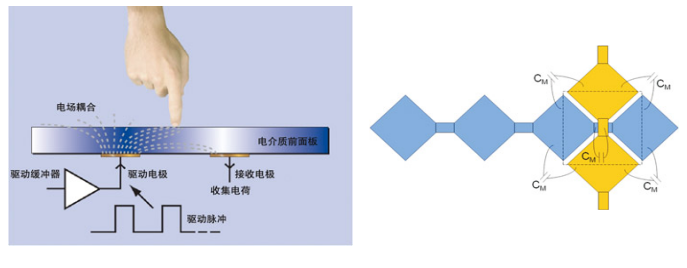
Take the double-layer self-capacitance structure as an example: two layers of ITO overlap each other to form M*N capacitors and M+N control channels. capacitive multi touch
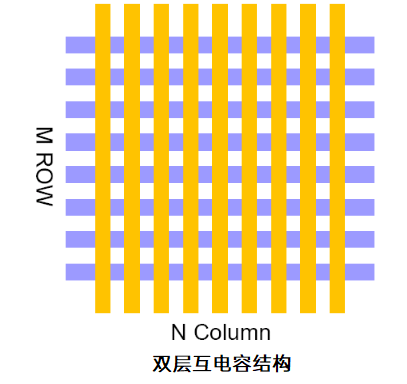
Multi-touch technology is based on mutually compatible touch screens and is divided into Multi-TouchGesture and Multi-Touch All-Point technology, which is multi-touch recognition of gesture direction and finger touch position. It is widely used in mobile phone gesture recognition and ten-finger touch. Waiting scene. Not only can gestures and multi-finger recognition be recognized, but other non-finger touch forms are also allowed, as well as recognition using palms, or even hands wearing gloves. The Multi-Touch All-Point scanning method requires separate scanning and detection of the intersection points of each row and column of the touch screen. The number of scans is the product of the number of rows and the number of columns. For example, if a touch screen consists of M rows and N columns, it needs to be scanned. The intersection points are M*N times, so that the change in each mutual capacitance can be detected. When there is a finger touch, the mutual capacitance decreases to determine the location of each touch point. capacitive multi touch
Capacitive touch screen structure type
The basic structure of the screen is divided into three layers from top to bottom, protective glass, touch layer, and display panel. During the production process of mobile phone screens, the protective glass, touch screen, and display screen need to be bonded twice.
Since the protective glass, touch screen, and display screen go through a laminating process every time, the yield rate will be greatly reduced. If the number of laminations can be reduced, the yield rate of full lamination will undoubtedly be improved. At present, the more powerful display panel manufacturers tend to promote On-Cell or In-Cell solutions, that is, they tend to make the touch layer on the display screen; while touch module manufacturers or upstream material manufacturers tend to favor OGS, which means the touch layer is Made on protective glass. capacitive multi touch
In-Cell: refers to the method of embedding touch panel functions into liquid crystal pixels, that is, embedding touch sensor functions inside the display screen, which can make the screen thinner and lighter. At the same time, the In-Cell screen must be embedded with a matching touch IC, otherwise it will easily lead to erroneous touch sensing signals or excessive noise. Therefore, In-Cell screens are purely self-contained. capacitive multi touch
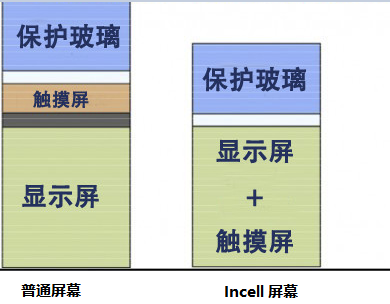
On-Cell: refers to the method of embedding the touch screen between the color filter substrate and the polarizer of the display screen, that is, with a touch sensor on the LCD panel, which is much less difficult than In Cell technology. Therefore, the most frequently used touch screen on the market is the Oncell screen. ips capacitive touch screen
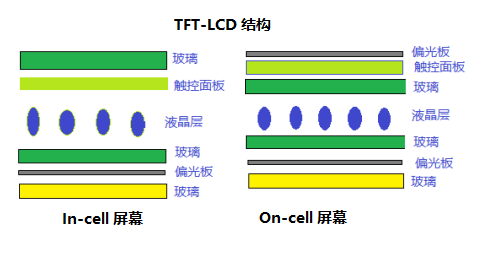
OGS (One Glass Solution): OGS technology integrates the touch screen and protective glass, coats the inside of the protective glass with an ITO conductive layer, and performs coating and photolithography directly on the protective glass. Since the OGS protective glass and touch screen are integrated together, they usually need to be strengthened first, then coated, etched, and finally cut. Cutting on tempered glass in this way is very troublesome, has high cost, low yield, and causes some hairline cracks to form on the edges of the glass, which reduce the strength of the glass. ips capacitive touch screen
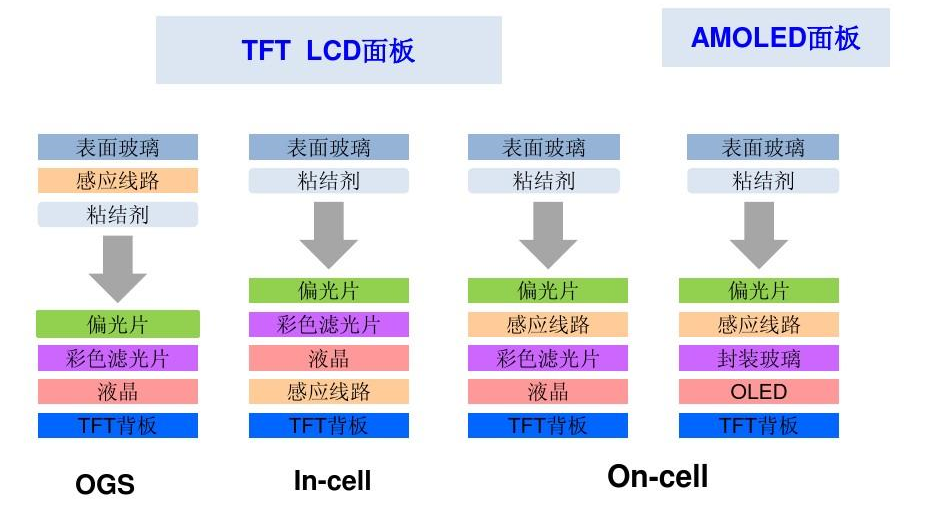
Comparison of advantages and disadvantages of capacitive touch screens:
1. In terms of screen transparency and visual effects, OGS is the best, followed by In-Cell and On-Cell. ips capacitive touch screen
2. Thinness and lightness. Generally speaking, In-Cell is the lightest and thinnest, followed by OGS. On-Cell is slightly worse than the first two.
3. In terms of screen strength (impact resistance and drop resistance), On-Cell is the best, OGS is second, and In-Cell is the worst. It should be pointed out that OGS directly integrates Corning protective glass with the touch layer. The processing process weakens the strength of the glass and the screen is also very fragile.
4. In terms of touch, the touch sensitivity of OGS is better than that of On-Cell/In-Cell screens. In terms of support for multi-touch, fingers, and Stylus stylus, OGS is actually better than In-Cell/On-Cell. Cell's. In addition, because the In-Cell screen directly integrates the touch layer and the liquid crystal layer, the sensing noise is relatively large, and a special touch chip is required for filtering and correction processing. OGS screens are not so dependent on touch chips.
5. Technical requirements, In-Cell/On-Cell are more complex than OGS, and production control is also more difficult. ips capacitive touch screen

Touch screen status quo and development trends
With the continuous development of technology, touch screens have evolved from resistive screens in the past to capacitive screens that are now widely used. Nowadays, Incell and Incell touch screens have long occupied the mainstream market and are widely used in various fields such as mobile phones, tablets, and automobiles. The limitations of traditional capacitive screens made of ITO film are becoming more and more obvious, such as high resistance, easy to break, difficult to transport, etc. Especially in curved or curved or flexible scenes, the conductivity and light transmittance of capacitive screens Poor. In order to meet the market's demand for large-size touch screens and users' needs for touch screens that are lighter, thinner and better to hold, curved and foldable flexible touch screens have emerged and are gradually used in mobile phones, car touch screens, education markets, video conferencing, etc. Scenes. Curved surface folding flexible touch is becoming the future development trend. ips capacitive touch screen
Post time: Sep-13-2023



